

100 User Experience Design & Evaluation Methods for Your Toolkit. OK, we’re only at number 19 so far, there’s still a way to go.
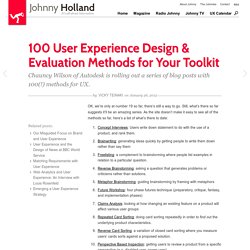
Still, what’s there so far suggests it’ll be an amazing series. As the site doesn’t make it easy to see all of the methods so far, here’s a list of what’s there to date: Each method comes with discussion of the strengths and weaknesses, as well as other resources. The list was started in January 2011, so we’ve probably got a while to go until we get the full list (6 months, eh?) , but it’s certainly worth keeping an eye on. Vicky Teinaki An England-based Kiwi, Vicky is doing a PhD at Northumbria University into how designers can better talk about touch and products. Design: work. Institute without Boundaries – Integrated Design Strategy. Service Design Toolkit – Downloads. Events in Instruction- 1-9. User centered solving problem - Design Thinking Action Lab. 33 Tips How to brainstorm creative ideas #INFOGRAFIA #INFOGRAPHIC. How To Think Visually Using Visual Analogies Most research in cognitive science explores how we see things but little research is done on how we understand what we see.
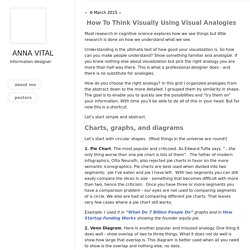
Understanding is the ultimate test of how good your visualization is. So how can you make people understand? Show something familiar and analogize. If you know nothing else about visualization but pick the right analogy you are more than half way there. How do you choose the right analogy? Let’s start simple and abstract. Charts, graphs, and diagrams Let’s start with circular shapes. 1. Example: I used it in “What Do 7 Billion People Do” graphs and in How Startup Funding Works showing the founder equity pie. 2. Example: I used it to visualize “The Anatomy Of determination” as a composition of 3 qualities: willfulness, discipline and ambition. 3. Example: I used it in "Going Through Anti-Success” chart. 4. Example: Calorie Intake and Outtake chart by 5W Infographics; When Genius Slept infographic. 5. 6. … riflessioni attorno alle.
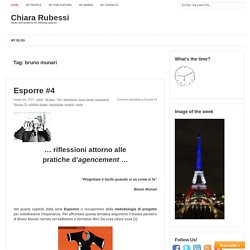
100 User Experience Design & Evaluation Methods for Your Toolkit. Our Design Led Innovation client consulting or facilitation sessions often involves a business diagnostic activity, that is split into something I fondly call: hard and soft diagnostics.
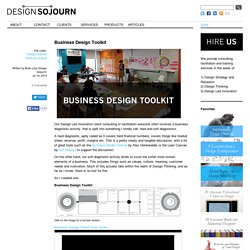
A hard diagnostic, aptly called as it covers hard financial numbers, covers things like market share, revenue, profit, margins etc. This is a pretty meaty and tangible discussion, with a lot of great tools such as the Business Model Canvas by Alex Osterwalder or the Lean Canvas by Ash Maurya to support the discussion. On the other hand, our soft diagnostic activity tends to cover the softer more human elements of a business. This includes things such as values, culture, meaning, customer needs and motivation. Much of this actually falls within the realm of Design Thinking, and as far as I know, there is no tool for this. Businesses traditionally use human-centered design to develop innovative solutions.

International Development Enterprises (IDE) and the design firm IDEO wondered: ”Why not apply the same approach to overcome challenges in the nonprofit world?” The Human-Centered Design Toolkit seeks to provide NGOs and social enterprises with the tools to do just that. Where does innovation come from? The HCD Toolkit is developed to help international staff and volunteers understand a community’s needs in new ways, find innovative solutions to meet those needs, and deliver solutions with financial sustainability in mind.For instance: in agriculture, innovation often comes from scientists, but not always effectively.
The Nike Foundation is dedicated solely to improving the lives of adolescent girls living in poverty, through unleashing the Girl Effect – the unique potential of 600 million adolescent girls to end poverty for themselves and the world.
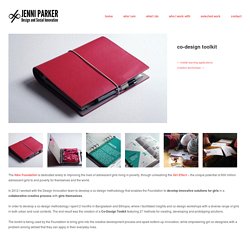
In 2012 I worked with the Design Innovation team to develop a co-design methodology that enables the Foundation to develop innovative solutions for girls in a collaborative creative process with girls themselves. In order to develop a co-design methodology I spent 2 months in Bangladesh and Ethiopia, where I facilitated insights and co-design workshops with a diverse range of girls in both urban and rural contexts. The end result was the creation of a Co-Design Toolkit featuring 27 methods for creating, developing and prototyping solutions. To critics, design thinking is both flawed and outdated.

To evangelists, design thinking has only just begun. But to kids? It’s a new card game on Kickstarter called Khandu ($33), by the studio Seven Thinkers. Goal: Think Big to Uncover Your Company’s Potential One of the most effective techniques to recognizing common dreams people have for your company is to ignore all limits and imagine what “could be.”
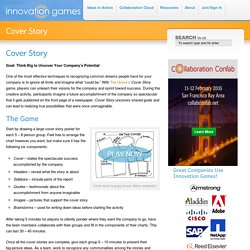
With The Grove’s Cover Story game, players can unleash their visions for the company and sprint toward success. During this creative activity, participants imagine a future accomplishment of the company so spectacular that it gets published on the front page of a newspaper. Cover Story uncovers shared goals and can lead to realizing true possibilities that were once unimaginable. Click here to play Cover Story instantly! Start by drawing a large cover story poster for each 5 – 8 person group.
Once all the cover stories are complete, give each group 5 – 10 minutes to present their big-picture ideas. Without a creative outlet, it is easy for companies to get stuck in a mundane slump, not progressing toward its potential. At Board of Innovation we always try to grasp the future.
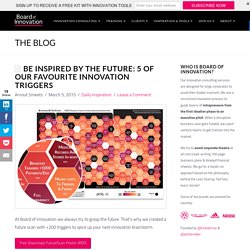
That’s why we created a future scan with +200 triggers to spice up your next innovation brainstorm. Free Download: FutureScan Poster (PDF) Are you always wondering what direction the future will take?